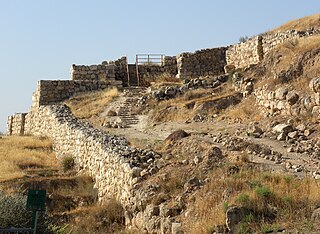
Lachish was an ancient Canaanite and Israelite city in the Shephelah region of Israel, on the south bank of the Lakhish River, mentioned several times in the Hebrew Bible. The current tell (ruin) by that name, known as Tel Lachish or Tell ed-Duweir, has been identified with the biblical Lachish. Today, it is an Israeli national park operated and maintained by the Israel Nature and Parks Authority. It lies near the present-day Moshav of Lakhish.

Ekron, in the Hellenistic period known as Accaron was a Philistine city, one of the five cities of the Philistine Pentapolis, located in present-day Israel.
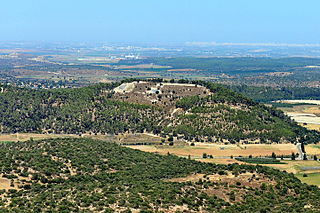
Azekah was an ancient town in the Shephela guarding the upper reaches of the Valley of Elah, about 26 km (16 mi) northwest of Hebron.

LMLK seals are ancient Hebrew seals stamped on the handles of large storage jars first issued in the reign of King Hezekiah and discovered mostly in and around Jerusalem. Several complete jars were found in situ buried under a destruction layer caused by Sennacherib at Lachish. While none of the original seals have been found, some 2,000 impressions made by at least 21 seal types have been published. The iconography of the two and four winged symbols are representative of royal symbols whose meaning "was tailored in each kingdom to the local religion and ideology".
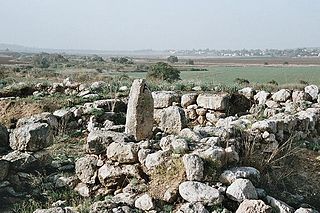
Timnath or Timnah was a Philistine city in Canaan that is mentioned in the Hebrew Bible in Judges 14 and in connection with Samson. Modern archaeologists identify the ancient site with a tell lying on a flat, alluvial plain, located in the Sorek Valley ca. 7 kilometres (4.3 mi) north-west of Beit Shemesh, near moshav Tal Shahar in Israel, known in Hebrew as Tel Batash or Teluliot Batashi (plural), and in Arabic as Tell Butashi or Teleilat Batashi (plural). The site is not to be confused with either the as yet unidentified Timna from the hill country of Judah, nor with the southern copper-smelting site of Timna in the Arabah near Eilat.

Gath or Gat was one of the five cities of the Philistine pentapolis during the Iron Age. It was located in northeastern Philistia, close to the border with Judah. Gath is often mentioned in the Hebrew Bible and its existence is confirmed by Egyptian inscriptions. Already of significance during the Bronze Age, the city is believed to be mentioned in the El-Amarna letters as Gimti/Gintu, ruled by the two Shuwardata and 'Abdi-Ashtarti. Another Gath, known as Ginti-kirmil also appears in the Amarna letters.

Frederick Jones Bliss was an American archaeologist.

Tel Maresha is the tell of the biblical Iron Age city of Maresha, and of the subsequent, post-586 BCE Idumean city known by its Hellenised name Marisa, Arabised as Marissa (ماريسا). The tell is situated in Israel's Shephelah region, i.e. in the foothills of the Judaean Mountains, about 2 kilometres (1.2 mi) southeast of Beit Gubrin.
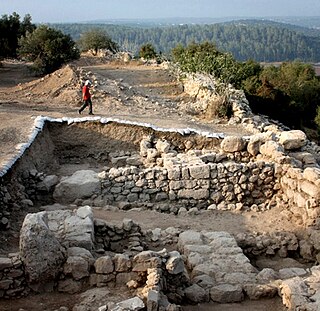
KhirbetQeiyafa, also known as Elah Fortress and in Hebrew as Horbat Qayafa, is the site of an ancient fortress city overlooking the Elah Valley and dated to the first half of the 10th century BCE. The ruins of the fortress were uncovered in 2007, near the Israeli city of Beit Shemesh, 30 km (20 mi) from Jerusalem. It covers nearly 2.3 ha and is encircled by a 700-meter-long (2,300 ft) city wall constructed of field stones, some weighing up to eight tons. Excavations at site continued in subsequent years. A number of archaeologists, mainly the two excavators, Yosef Garfinkel and Saar Ganor, have claimed that it might be one of two biblical cities, either Sha'arayim, whose name they interpret as "Two Gates", because of the two gates discovered on the site, or Neta'im; and that the large structure at the center is an administrative building dating to the reign of King David, where he might have lodged at some point. This is based on their conclusions that the site dates to the early Iron IIA, ca. 1025–975 BCE, a range which includes the biblical date for the biblical Kingdom of David. Others suggest it might represent either a North Israelite, Philistine, or Canaanite fortress, a claim rejected by the archaeological team that excavated the site. The team's conclusion that Khirbet Qeiyafa was a fortress of King David has been criticised by some scholars. Garfinkel (2017) changed the chronology of Khirbet Qeiyafa to ca. 1000–975 BCE.
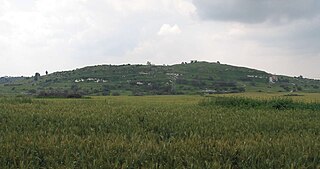
Tell es-Safi was an Arab Palestinian village, located on the southern banks of Wadi 'Ajjur, 35 kilometers (22 mi) northwest of Hebron which had its Arab population expelled during the 1948 Arab–Israeli war on orders of Shimon Avidan, commander of the Givati Brigade.
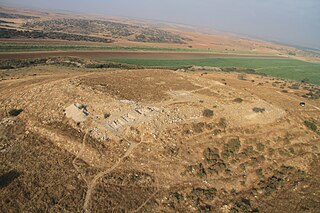
Tel Burna is an archaeological site located in the Shephelah, along the banks of Nahal Guvrin, not far from modern-day Qiryat Gat. Tel Burna is located near Beit Guvrin/Maresha, Tel Goded, Lachish, Tell es-Safi/Gath and Tel Zayit. The site is thought to have been one of a series of sites along the border between Judah and Philistia.
Seymour Gitin is an American archaeologist specializing in ancient Israel, known for his excavations at Tel Miqne-Ekron. He was the director of the Albright Institute of Archaeological Research (AIAR) in Jerusalem from 1980 to 2014.
Moresheth-Gath, also Moreshet-Gat, was a town of the tribe of Judah in ancient Israel mentioned in the Bible. It was located in the Shephelah region between Lachish and Achzib.
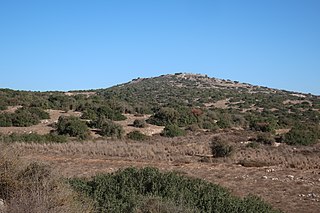
Tell ej-Judeideh is a tell in modern Israel, lying at an elevation of 398 metres (1,306 ft) above sea-level. The Arabic name is thought to mean, "Mound of the dykes." In Modern Hebrew, the ruin is known by the name Tell Goded.

Tel Erani or Tell esh-Sheikh Ahmed el-ʿAreini is a multi-period archaeological site on the outskirts of Kiryat Gat in the Southern District of Israel. It is also known by the name ʻIrâq el-Menshiyeh, although thought to have borne the original Arabic name of Menshiyet es-Saḥalīn. The tell was first occupied in the Chalcolithic period, but its most notable remains are from the Bronze Age and Iron Age, when it was the site of a substantial Philistine city with links to Egypt. It has been identified with the biblical cities of Libnah, Gath, Mmst, Eglon and Makkedah, but none of these identifications are certain. The city was destroyed in the 6th century BCE, possibly by the Babylonians. In the Persian period, it was the site of a temple. There are also signs of settlement in the Hellenistic, Byzantine, and Mamluk periods. The Palestinian village of Iraq al-Manshiyya was located at the foot of the tell until it was depopulated in the 1948 Arab–Israeli War.

Oded Lipschits is an Israeli professor in the Department of Archaeology and Ancient Near East Studies at Tel Aviv University. In 1997 he earned his Ph.D. in Jewish History under the supervision of Nadav Na'aman. He has since become a Senior Lecturer and Full Professor at Tel Aviv University and served as the Director of the Tel Aviv Institute of Archaeology since 2011. Lipschits is an incumbent of the Austria Chair of the Archeology of the Land of Israel in the Biblical Period and is the Head and founder of the Ancient Israel Studies Masters program in the Department of Archaeology and Ancient Near East Studies.

Chezib, also known as Achzib of Judah, is a biblical place-name associated with the birth of Judah's son, Shelah (Genesis 38:5), corresponding to the Achzib of the Book of Joshua (15:44), a town located in the low-lying hills of the plain of Judah, known as the Shefela. In I Chronicles 4:22, the town is rendered as Chozeba. The place is now a ruin.

Tel Yarmuth or Khirbet Yarmuk is an ancient Near East archaeological site in Israel located 25 kilometers southwest of Jerusalem and near modern Beit Shemesh. It is a large primarily single-period site and has been suggested as possibly being the city of Jarmuth, being only a tentative identification, as it is based solely on the similarity of the Hebrew name with the Arabic name and its areal location.

The Al Jib jar handles are over 60 jar handles inscribed with names including the Semitic triliteral gb'n, discovered between 1956 and 1959 in excavations led by James B. Pritchard at the "great pool" of the Palestinian town of Al Jib. This excludes approximately 80 handles found in the same location with the LMLK seal inscription which has been found elsewhere across the region. The discovery was the largest number of inscriptions found anywhere in Palestine since the Samaria ostraca in 1908-10.

















